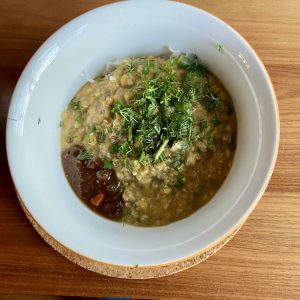Recipe: divine dhal
Dhal, aka lentils and spice, is a handy ‘template’ recipes. Once you’ve got a hang of the basics there are infinite variations, making it a perfect standby meal.
The quickest version uses red lentils. These require no soaking, just rinse and go. If you’re using green (brown) lentils or other pulses, it’s a good idea to soak for a couple of hours and increase the cooking time. Check out this handy guide to Indian pulses for more information.
Dhal is perfect if you can’t handle hot food, as chillies are entirely optional. When eating with others who desire different levels of heat, you can skip the chillies and serve with sambal olek (a pre-made chilli condiment) or some chopped fresh chillies.
Basic dhal recipe
(Quantities are flexible – this recipe serves 2 to 4, depending on whether a side or main dish with rice)
1-2 tablespoons vegetable oil, coconut oil or ghee
1 large onion (brown, red or a couple of shallots), diced
2-3 cloves garlic, crushed
1 thumb-sized knob fresh ginger, finely chopped or grated
1 heaped teaspoon mustard seeds (optional)
1-2 green chillies, finely sliced (optional)
2 level teaspoons dried spices (eg. turmeric and/or roasted and crushed cumin and coriander seeds), garam masala or curry powder
1 cup red lentils, rinsed well
2-3 cups vegetable stock or water
Salt if required
Lemon or lime juice (optional)
More optional extras
Add some or all of the following for a deluxe dhal.
- 1 cup pumpkin, diced small (buttercup pumpkin is my favourite)
- 2 cups spinach or green leafy veg, rinsed and shredded)
- 1-2 ripe tomatoes, diced
- 1 cup coconut milk (leftover milk can be frozen and used later)
- Fresh coriander leaves
In a pot or large frying pan, sauté the onion in oil until soft. Add garlic, ginger, chilli and mustard seeds. Stir until the seeds start to pop, then add dried spices and move them around the pan for another minute or so until you can smell the spicy aroma. Stir through the lentils and add 2 cups of stock or water (only 1 cup initially if adding coconut milk and/or tomatoes).
Bring to a simmer. If adding vegetables, tomatoes or coconut milk do so now. Stir occasionally, adding more stock or water as required. Dhal is usually the consistency of porridge (though some prefer it more like a soup). You need enough fluid to cook the lentils (and vegetables if added).
Simmer for around 40 minutes on low, partially covered with a lid, until the lentils (and vegetables) are soft. Don’t forget to stir and check if there’s enough fluid. If it’s too soupy once the lentils are cooked, simmer with the lid off until the desired consistency. Once cooked, taste the dhal and add salt if required (it may not need any if you’re using stock). Turn off the heat. Stir through a squeeze of lemon and coriander leaves for a bit of zing, if desired.
Serve with brown basmati rice or over steamed vegetables, and with chutney and pickles (mango is my favourite) if you have any. This vegan raita is perfect.

This recipe is vegan, dairy-free and gluten-free (and utterly delicious). For more amazing recipes check out the resources section and sign up for the free monthly newsletter.
Confused about food? Book a Wellbeing Plan for some expert guidance to create a way of eating that suits your body.
Similar Posts:
Social Share
6 Comments
Leave a Reply
You must be logged in to post a comment.






Pingback: Gill Stannard Are you eating enough fruit and vegetables? - Gill Stannard
Pingback: Gill Stannard Menopause part two: natural remedies to stop hot flushes - Gill Stannard
Pingback: Gill Stannard What to eat when the weather turns cold - Gill Stannard
Pingback: Gill Stannard » Recipe: vegan raita
Pingback: Gill Stannard » Delicious bowls of goodness
Pingback: Gill Stannard » Update: Spring 2022